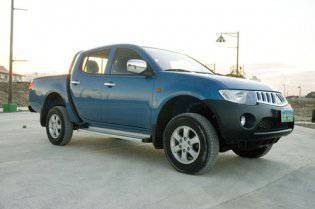Which mini car will find its way to the hearts (and wallets) of the budget-conscious Pinoy?
CHANA BENNI
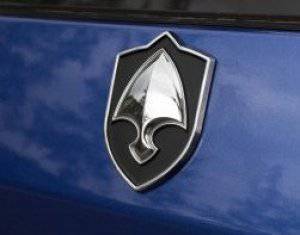 THE BENNI is positioned to compete against the Honda Jazz, the Chevy Aveo, and other subcompacts of similar size and engine displacement. As the newest Chinese-made car to enter our market, the brand hopes to alter China’s less-than-favorable image in the auto industry. Will it be successful? How will it compare with the Chery QQ2 that we are pitting it against? Will it emerge triumphant?
THE BENNI is positioned to compete against the Honda Jazz, the Chevy Aveo, and other subcompacts of similar size and engine displacement. As the newest Chinese-made car to enter our market, the brand hopes to alter China’s less-than-favorable image in the auto industry. Will it be successful? How will it compare with the Chery QQ2 that we are pitting it against? Will it emerge triumphant?
Price: P438,000
Maximum output: 84 horsepower
Maximum torque: 110 Newton meter
CHERY QQ3
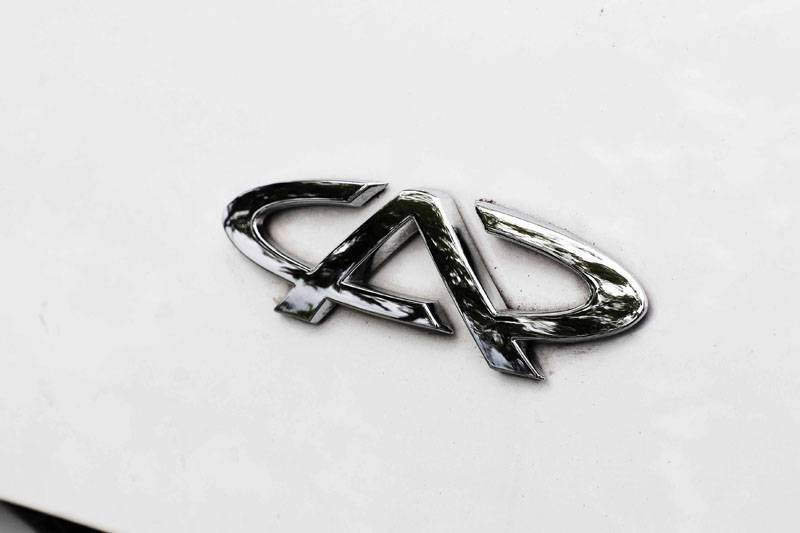 AS PREDICTED by TG in our feature story on the QQ3 in December 2007, the ‘smiling’ car has found its way to the fleets of many large corporations. Its diminutive size, affordable price, and fuel efficiency are too difficult to ignore. Issues with fit and finish did not cause too much of a fuss since the engine is what really counts. So the question remains: will the Chery QQ3 be the next car for the masses?
AS PREDICTED by TG in our feature story on the QQ3 in December 2007, the ‘smiling’ car has found its way to the fleets of many large corporations. Its diminutive size, affordable price, and fuel efficiency are too difficult to ignore. Issues with fit and finish did not cause too much of a fuss since the engine is what really counts. So the question remains: will the Chery QQ3 be the next car for the masses?
Price: P349,000
Maximum output: 68 horsepower
Maximum torque: 90 Newton meter
CHANA BENNI
THE BENNI may be the new kid on the block in the Philippines, but back in China, the Chang’an brand has been building cars since 1957. With more experience under its belt compared to Chery (which has only been in the game since 1997), it is expected that the Benni will showcase more sophistication and build quality than the QQ it competes with in this month’s comparo (which, by the way, is not a word ‘coined’ by a Filipino).
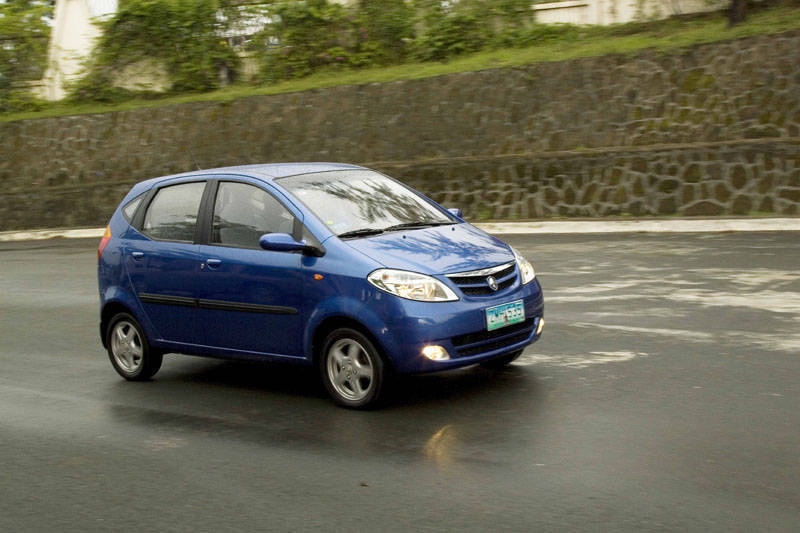 It looks like a miniature Mercedes-Benz A-Class, but without trying too hard. That is a good thing, of course, considering the Chinese have gained notoriety for blatantly copying the designs of their western counterparts, right down to the dimensions. Rumor has it that the doors of the Chevy Spark will fit perfectly on the QQ—and vice versa. At least, the Benni is smaller than the Benz, so Chana should be given a little bit of credit for that.
It looks like a miniature Mercedes-Benz A-Class, but without trying too hard. That is a good thing, of course, considering the Chinese have gained notoriety for blatantly copying the designs of their western counterparts, right down to the dimensions. Rumor has it that the doors of the Chevy Spark will fit perfectly on the QQ—and vice versa. At least, the Benni is smaller than the Benz, so Chana should be given a little bit of credit for that.
It is a consensus among the TG team that the Benni’s looks are pleasant, and judging from the exterior, there should be loads of space in that tight package—at least, more than the QQ. If someone didn’t know any better, they might think the Benni was imported from Europe. Its lines are clean-cut, and the flat planes add to its city-street appeal. It is cute, but certainly not pa-cute.
Inside, plastic abounds, but it doesn’t look too shabby. Actually, it is quite clean in here and modern. You get a host of convenience features that include an in-dash CD player, keyless entry, power windows and door locks, and a digital odometer and trip meter. Taller drivers will fit comfortably enough. Rear passengers will have to deal with the lack of space though, but that is expected. When it comes to cargo space, the rear splits down 60/40—a convenient feature if you want to haul a couple of bags with you. Things are indeed promising.
Look over the brochure and you’ll find that the specification sheet is impressive. Under the minuscule hood of the Benni lies a 1.3-liter, 16-valve, four-cylinder engine. Twist the ignition and the engine comes alive with a somewhat throaty growl. We like the sound, of course, but aural stimulation can only go so far. More about the engine later. Another feature that is notable is the electronic power steering (a feature that belongs in Bavarian territory). An antilock braking system (which works hand in hand with EBD) also comes standard. These specifications all belong in higher-end cars, so it goes without saying that the Benni has toys that are in the league of your regular Japanese sedan. Not bad considering the price tag.
Although it all looks good on paper, how the car (with its high-tech specs) comes together when you finally hit the road is another story. Like almost all of the Chinese cars that we have encountered since the invasion, the transmission needs some work. More development is needed, we believe.
You need muscle to notch the Benni into the right gear, and it takes plenty of getting used to. For a car of this size, it is strange to have to drive it like it was an old American car with a clunky gearbox. After a few kilometers, it will become second nature and not something to worry about. However, how the transmission mates to the engine is a cause for concern. You see, there were moments when it seemed like the car had a life of its own. While shifting through the gears, the engine has a tendency to rev up when you least expect it to, even without any throttle input. When shifting to a lower a gear, blipping the throttle sometimes does not elicit an immediate response. What is going on here? Perhaps the kinks haven’t been smoothened out yet? This is one of the first demo units to be set loose after all. You get used to the erratic throttle after a while, but it isn’t normal.
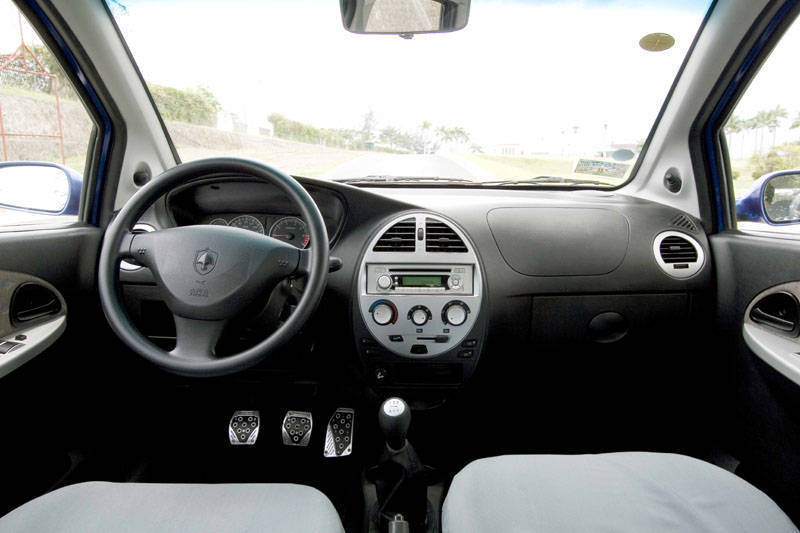 For a car of its size, the Benni feels much larger than it is. This could be seen as a good thing or a bad thing. The chassis feels very solid, much more so than the QQ’s. There is hardly a rattle when going over the rough stuff, and when taking corners, the entire car feels planted enough.
For a car of its size, the Benni feels much larger than it is. This could be seen as a good thing or a bad thing. The chassis feels very solid, much more so than the QQ’s. There is hardly a rattle when going over the rough stuff, and when taking corners, the entire car feels planted enough.
The steering feel is quite odd though. It is a little too firm (probably because the electronic aid makes it heavier than it should be). It takes away some of the nimbleness that you would expect from a car of this size.
Revving hard also elicits squeals from the engine bay. It appears that some of the belts (particularly the one that connects to the A/C compressor) are a little on the tight side. This is something that is never expected from a brand-new car.
Admittedly, much is expected from the Chana Benni, especially as the QQ was given a bit of flogging when it first arrived. Have the tables turned in favor of the ‘lowly’ QQ?
CHERY QQ3
WE ADMIT that we were a bit harsh with our criticism when we first got our hands on the Chery QQ last year. The reason for this was that we compared it to what was available from the Japanese and the Koreans.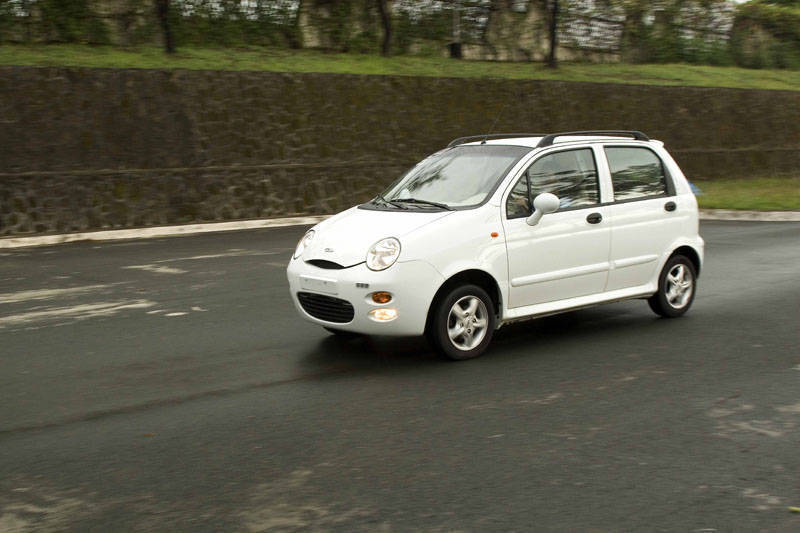 Sure, the badges came loose and the doors were misaligned, but now those ‘little’ details don’t seem so important anymore. The QQ is, in fact, the cheapest car on the market, so we shouldn’t complain too much. What are we, spoiled brats? And who cares if it looks like the Chevy Spark?!
Sure, the badges came loose and the doors were misaligned, but now those ‘little’ details don’t seem so important anymore. The QQ is, in fact, the cheapest car on the market, so we shouldn’t complain too much. What are we, spoiled brats? And who cares if it looks like the Chevy Spark?!
We were also able to spend more kilometers behind the wheel this time around, and boy, were we surprised!
The QQ is very preppy for a 1.1-liter, four-cylinder sprite. The engine is sourced from an Austrian company called AVL, and it does the job of propelling the QQ with gusto. We liked how the throttle was lightning-quick and how it responded to the smallest amount of throttle input. With a car of this size, that trait is very crucial if you want to survive the streets of Metro Manila. Darting in and out of tight spaces was a joy, and we have to admit that driving the QQ is addictive. It is really like a go-kart on steroids, and it likes to be abused with plenty of pedal-to-the-metal maneuvering. Don’t expect top speed to be phenomenal since the QQ is a city-oriented car, but it can handle our tight city streets with plenty of zip.
Would we have noticed these positive traits if the Chana Benni didn’t arrive to challenge the QQ to a Shanghai showdown? To be completely honest, probably not. At least now we can see that even among Chinese-made cars, the quality levels still vary greatly from brand to brand. Not all of them are created equal.
But alas, the QQ—despite being the easier car to drive in this month’s Big Test—is far from being the perfect car. The transmission is still vague and needs a special flick of the wrist to engage the gears properly. This takes a little practice, but after a while the shift action will really grow on you. Soon enough, the QQ will feel like a toy car that you can throw around effortlessly and without any guilt.
There are still issues about the fit and finish of the interior trim, but again we have to emphasize that a car at this price level will not have the interior quality of, say, a Honda. These shortcomings are actually not very obvious unless you subject the QQ to extreme scrutiny. In fact, the interior is very pleasant and upbeat. The beige scheme does plenty to make passengers feel welcome. The chrome-rimmed gauges even add a touch of elegance and class to the dash. The materials don’t feel as inferior the second time around. This goes to show that sometimes first impressions don’t always count.
There are also some pleasant surprises like the power windows that close automatically when you activate the alarm, and power side mirrors that add a simple dash of luxury. Like the Benni, the QQ is also equipped with ABS. We didn’t attempt to test this feature though. How it is possible to throw these features in at this price is a mystery, but they are welcome nonetheless. Outside, you get a roof rack and HID bulbs for that added bling factor.
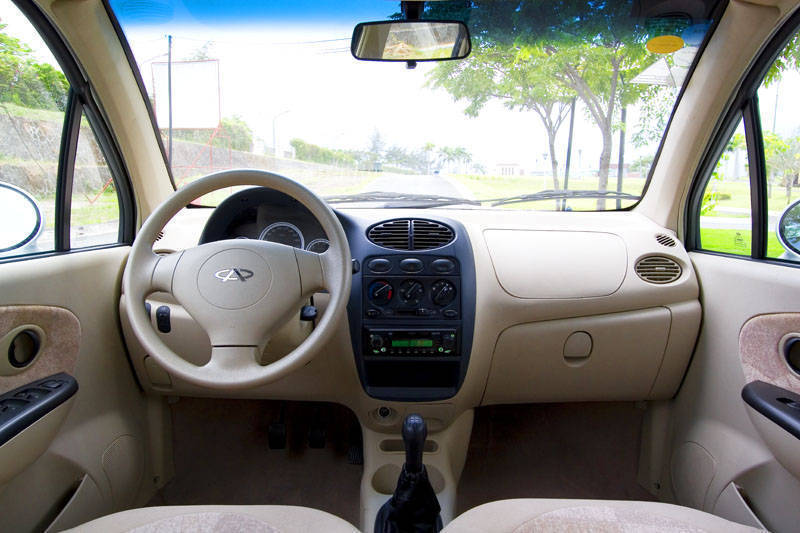 There are so many convenience features packed into the QQ that make it very enticing for the first-time car buyer. But since the Chery is still relatively new to us, we aren’t sure how well the unit will hold up after long-term use and abuse.
There are so many convenience features packed into the QQ that make it very enticing for the first-time car buyer. But since the Chery is still relatively new to us, we aren’t sure how well the unit will hold up after long-term use and abuse.
Fortunately, the spare parts are really, really cheap. A replacement window only costs P600! Are the prices too good to be true? Is quality sacrificed? Many so-called experts have gone as far as calling Cherys ‘rolling coffins’ due to their inability to pass stringent crash tests. But really, what can you expect from a company that only began manufacturing cars recently? But it has to be noted that the Benni is claimed to be more crash-worthy than the QQ.
The Chery QQ can deliver on its promise of being an affordable transport for first-time car buyers on a very tight budget. What we like about the QQ is that despite its limitations, the engineers behind it tried their best to make do with what they had. It isn’t as much of a slipshod job as many people might think. And surprisingly, it is very comfortable inside.
We find the QQ to be an endearing automobile. Nobody who has gotten behind the wheel of one can deny that. Look at it smile. Isn’t it just so damn cute? Plus, if you want to buy a QQ, Chery dealerships have sprouted like mushrooms not only in Metro Manila but all over the archipelago as well.
Give the Chinese a few more years and their cars will be at par with their Korean-made counterparts. You can quote Top Gear on that.
THE VERDICT
AT FIRST glance, this comparison will seem like a mismatch. The Benni is obviously targeted at a more ‘upscale’ market while the humble QQ falls on a lower rung in the automotive ladder. But upon closer inspection, these cars have plenty in common. Engine specification aside, both are manufactured in China and are newcomers to the Philippines. Both also fall under the hatchback category. And compared to other Japanese- and Korean-made brands, Chana and Chery make very affordable cars.
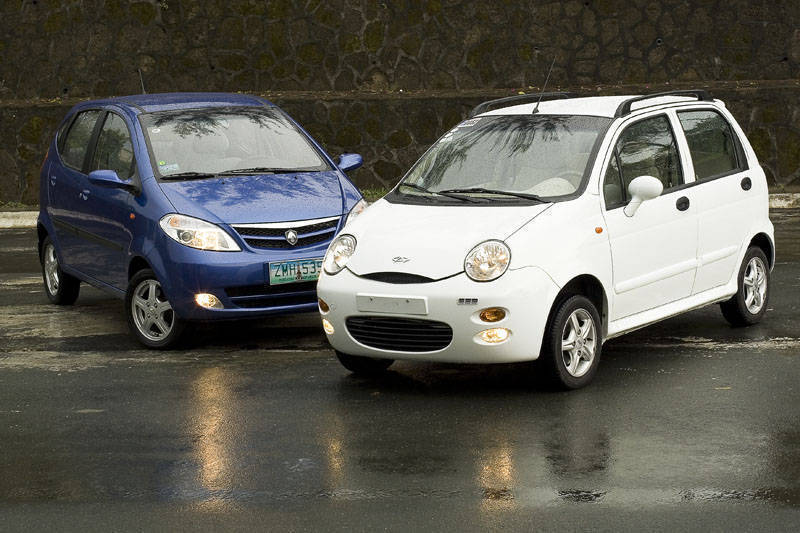 The Benni is still a long way off from being on a par with the Honda Jazz but considering it is priced significantly cheaper, that should be expected. But put it in the same ring as the QQ, the Benni should be the winner, right? Unfortunately, we don’t think so.
The Benni is still a long way off from being on a par with the Honda Jazz but considering it is priced significantly cheaper, that should be expected. But put it in the same ring as the QQ, the Benni should be the winner, right? Unfortunately, we don’t think so.
On the QQ’s ground, even the Benni falls short. Until its throttle-control problem is solved, the belts in the engine bay stop squaking during hard revving and the gauges stop dancing around, it is hard to justify its price against the QQ’s.
Chery’s little wonder may be lacking in the fit and finish department and its chassis may not be as solid as the Benni’s but it shines where it counts. Its AVL engine is enthusiastic and the throttle input is direct and precise. We might have been hard on the QQ the first time but we now see why its sales are climbing. At least, you know that when you get behind the wheel, you are in full control. There won’t be any surprises with the throttle response, and you can drive with confidence. The Chery QQ is the cheap little car that could – at P89,000 less.



